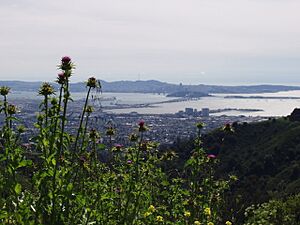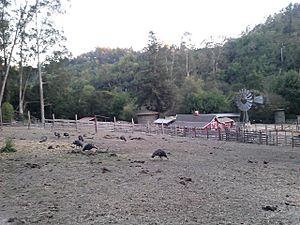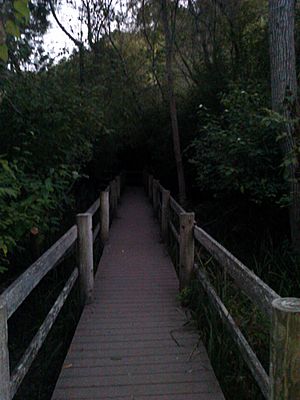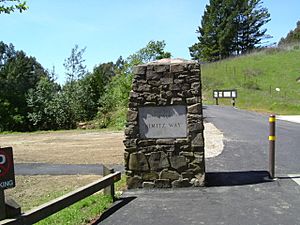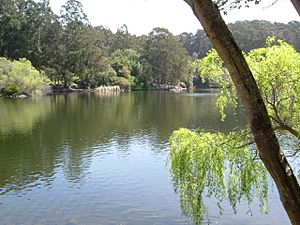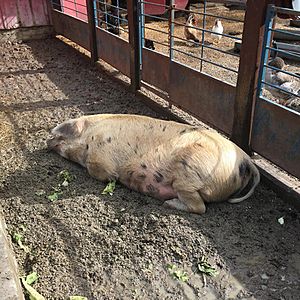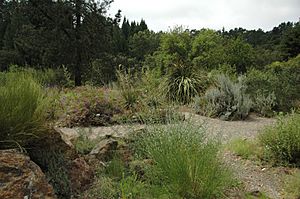Tilden Regional Park facts for kids
Quick facts for kids Tilden Regional Park |
|
|---|---|
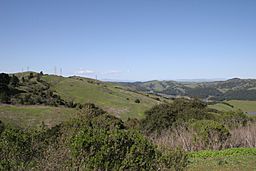
Looking northeast from "Inspiration Point" in Tilden, March 2006
|
|
| Lua error in Module:Location_map at line 420: attempt to index field 'wikibase' (a nil value). | |
| Location | Berkeley Hills |
| Area | 2,079-acre (841 ha) |
| Created | 1936 |
| Operated by | East Bay Regional Park District |
Tilden Regional Park, also called Tilden Park, is a large park in the San Francisco Bay Area of California. It covers about 2,079 acres (841 hectares). The park sits between the Berkeley Hills and San Pablo Ridge. Its main entrances are close to the towns of Kensington, Berkeley, and Richmond. Tilden Park is also right next to Wildcat Canyon Regional Park.
The East Bay Regional Park District takes care of Tilden Park. This park was created from the very first land the District bought in 1936. Tilden Regional Park is named after Charles Lee Tilden. He was a local leader who helped start the East Bay Regional Park District.
Contents
Where is Tilden Park Located?
Most of Tilden Park is in Contra Costa County. Some parts are also within the cities of Oakland and Berkeley. The park has steep valleys and thick forests. This makes it feel like a wild place, even though it is close to big cities. From its high hills, you can see wide views of the San Francisco Bay. You can also see Mount Diablo in the distance.
The eastern edge of the park is near the top of the San Pablo Ridge. The western edge is close to the top of the Berkeley Hills.
Some areas of the park were once used for farming. People also planted non-native trees like eucalyptus. There are even some giant sequoia trees that were planted more recently. Today, park workers are trying to bring back native plants. Many parts of the park are covered in native coastal scrub. The park district uses goats to help control plants in the summer.
You can get to the park by bus on weekends. AC Transit bus line 67 runs from the Berkeley BART station into the park. It stops at places like the Tilden Nature Area, Lake Anza, and the Brazilian Room.
History of Tilden Regional Park
Before it became a public park, the land was home to the Ohlone Native American people. Later, Spanish explorers and Mexican ranch owners moved the Ohlone people away. Ranching then became the main activity in Wildcat Canyon. In the late 1800s and early 1900s, families like the Currans owned ranches here.
The East Bay Regional Park District bought the first parkland on June 4, 1936. This land came from the East Bay Municipal Utility District. The purchase included land for Tilden Park, Lake Temescal, and Robert Sibley Volcanic Regional Preserve. On July 16, 1936, the park was officially named "Charles Lee Tilden Regional Park."
Building the Park: The New Deal Era
In 1936, the park district got money to develop the park. They used local funds to get federal money for park projects. From 1935 to 1941, a Civilian Conservation Corps (CCC) camp was in the Tilden Nature Area. CCC workers built many of the park's early features. This included roads, trails, bridges, picnic spots, and the golf course.
Works Progress Administration (WPA) workers also helped. They built the Lake Anza dam and stone buildings. These include restrooms and the outside of the Brazilian Room. The look of the park today comes from the work of the CCC and WPA. Many of these stone buildings and features are still in the park. The stone used for these buildings came from a quarry inside the park.
Tilden Park and World War II
In 1942, during World War II, part of Tilden Park was used by the United States government. They built the Grizzly Peak VHF Station there. This radio site helped control air defense radar sites. It was also a radio station for Hamilton Air Force Base.
In 1952, the U.S. Army opened an anti-aircraft site near Vollmer Peak. This site had large guns to protect against enemy planes. It was closed later during the Cold War. This happened when a Nike missile base opened nearby. The land was given back to the park district in 1959. Today, a large concrete bunker from that time is used by park maintenance.
During World War II, Camp Wildcat Canyon was used for soldiers to recover. On Labor Day in 1942, the Kaiser Richmond Shipyards held a huge picnic at Tilden Park. About 10,000 workers and their families attended. This was the biggest event in Tilden Park's history.
Nimitz Way is a path that goes through the park. It was named in 1955 after Admiral Chester W. Nimitz. He was a famous U.S. Navy leader. This path was first built as a road for military sites during the wars. Now, it's a popular path for walking, running, and biking. Admiral Nimitz used to hike in the park and spread wildflower seeds.
After the War: New Attractions
After World War II, Tilden Park added more fun things to do. These included pony rides, a model airplane field, and tennis courts. The Tilden Park Merry-Go-Round opened in 1948. The South Gate & Pacific Railway (now the Redwood Valley Railway) started in 1952. With these new attractions, Tilden Park became a favorite spot for families.
Fun Things to Do in Tilden Park
Tilden Park has many wild areas. It also has several developed spots for visitors to enjoy. These include places for learning about nature, a large garden, a swimming lake, a golf course, a small farm, a miniature train, and a merry-go-round.
The Environmental Education Center and the Little Farm are in the Tilden Nature Area. The Education Center has programs and exhibits about local wildlife. The Little Farm is a model farm with animals like cows, sheep, goats, pigs, and chickens. Visitors can feed the animals and learn about farm life.
Lake Anza is in the middle of Tilden Park. You can swim there from May to September. Hiking trails and picnic areas around the lake are open all year.
The Regional Parks Botanic Garden has many California native plants. It covers 10 acres and includes rare plants.
The Redwood Valley Railway is a small train ride. It started in 1952. The track is 1.25 miles long, and the ride takes about 12 minutes. Over 160,000 people ride it each year.
The Brazilian Room is a place for events and parties. It is also in the central part of the park.
The Tilden Park Merry-Go-Round is an old merry-go-round built in 1912. It is listed as a historic place.
The Tilden Park Golf Course is an 18-hole public golf course. It was designed by William Park Bell. WPA workers built it. The golf course officially opened on November 11, 1937.
Popular Trails for Exploring
The park has many trails for hiking, horseback riding, and bicycling. Most trails allow dogs, but dogs are not allowed in the Tilden Nature Area. Some of the main trails are:
The Tilden Nature Area is the northern part of the park. It has 740 acres and 10 miles of hiking trails. These trails include a climb to Wildcat Peak. There is also a trail and boardwalk around Jewel Lake.
Nimitz Way is a paved trail about four miles (6 km) long. It starts at Inspiration Point and goes north along the hills. It crosses into Wildcat Canyon Regional Park. Nimitz Way is popular because it's paved and not very steep. From Nimitz Way, you can see great views of the San Francisco Bay. You can also see EBMUD’s San Pablo and Briones Reservoirs, and Mount Diablo.
Meadows Canyon-Curran-Wildcat Canyon loop is a trail about 1.43 miles long. It has a steady climb. At the top, it connects to Curran trail, which goes downhill to Wildcat Gorge trail. This loop is a little under 3 miles in total.
East Bay Skyline Ridge Trail (or Seaview Trail) offers views of San Francisco Bay and Mt. Diablo. It is about 2.7 miles long.
South Park Drive is a road that closes from November 1 to March 31 each year. This is to protect newts that migrate. When it's closed to cars, it's open for hiking.
Picnic Areas and Camping
Tilden Park has 13 picnic areas you can reserve. There are also many picnic areas you don't need to reserve. They have different features like water, grills, and bathrooms. They can hold groups from 35 to 150 people. Besides the official picnic spots, many trails have benches with great views.
Tilden Regional Park also has three group campsites. New Woodland can hold 50 people. Gillespie Youth Camp and Wildcat View can hold 75 people each. Es Anderson Equestrian Camp is for camping with horses.
See also
 In Spanish: Parque regional Tilden para niños
In Spanish: Parque regional Tilden para niños


